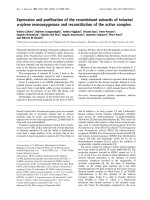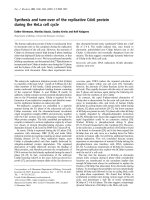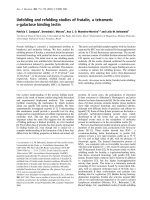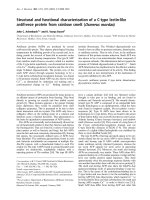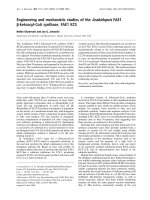Báo cáo y học: " Clinical and economic ramifications of switching antipsychotics in the treatment of schizophreniab" pptx
Bạn đang xem bản rút gọn của tài liệu. Xem và tải ngay bản đầy đủ của tài liệu tại đây (297.67 KB, 9 trang )
BioMed Central
Page 1 of 9
(page number not for citation purposes)
BMC Psychiatry
Open Access
Research article
Clinical and economic ramifications of switching antipsychotics in
the treatment of schizophrenia
Douglas E Faries*
1
, Haya Ascher-Svanum
2
, Allen W Nyhuis
1
and
Bruce J Kinon
3
Address:
1
US Statistics, Lilly USA, LLC, Indianapolis, IN, USA,
2
US Outcomes Research, Eli Lilly and Company, Indianapolis, IN, USA and
3
Psychosis Medical, Eli Lilly and Company, Indianapolis, IN, USA
Email: Douglas E Faries* - ; Haya Ascher-Svanum - ; Allen W Nyhuis - ;
Bruce J Kinon -
* Corresponding author
Abstract
Background: Switching between antipsychotic medications is common in the treatment of
schizophrenia. However, data on clinical and economic outcomes from antipsychotic switching, in
particular acute care service use, is fairly limited. The goal of this research was to assess the clinical
and economic ramifications of switching antipsychotics during outpatient management of
schizophrenia.
Methods: Data from a 1-year randomized, open-label cost-effectiveness study involving typical and
atypical antipsychotics were assessed. The study protocol permitted switching of antipsychotics
when clinically warranted. The risk of crisis-related events, use of acute-care services, and the time
to the initial use of such services were determined in outpatients who switched antipsychotics
compared with those who continued with their initial medications. Health care resource utilization
data were abstracted from medical records and other sources (e.g., patient self-report), and direct
costs were estimated using previously published benchmarks.
Results: Almost one-third of patients (29.3%) underwent a switch from their initial antipsychotic
agent, with an average duration of 100 days before such treatment alterations. Compared with
their counterparts who remained on their initial therapies, individuals who switched antipsychotics
experienced a significantly higher risk of acute-care services, including hospitalization (p = .013) and
crisis services (p = .011). Patients undergoing medication switches also used acute-care services
significantly sooner (p = .004) and accrued an additional $3,000 (a 25% increase) in annual total
health care costs per patient, most of which was due to acute-care expenditures.
Conclusion: Switching antipsychotic medications was found to be associated with considerably
poorer clinical and economic outcomes, as reflected by, more frequent and more rapid use of
acute-care services compared with persons remaining on their initial treatments.
Trial Registration: Trial ID 2325 in LillyTrials.com (also accessible via ClinicalStudyResults.org).
Published: 2 September 2009
BMC Psychiatry 2009, 9:54 doi:10.1186/1471-244X-9-54
Received: 21 November 2008
Accepted: 2 September 2009
This article is available from: />© 2009 Faries et al; licensee BioMed Central Ltd.
This is an Open Access article distributed under the terms of the Creative Commons Attribution License ( />),
which permits unrestricted use, distribution, and reproduction in any medium, provided the original work is properly cited.
BMC Psychiatry 2009, 9:54 />Page 2 of 9
(page number not for citation purposes)
Background
Antipsychotic medications are mainstays in the manage-
ment of schizophrenia, yet many patients experience sub-
optimal improvement (or even worsening) in the core
symptoms of their disease or intolerance to their initially
prescribed treatments [1-3]. Under such conditions, a
clinically indicated change (i.e., switch) in antipsychotics
represents a viable treatment option, and such alterations
are not uncommon among patients with schizophrenia
[3-11]. Clinically warranted switches often confer tangible
benefits by enhancing treatment effectiveness and tolera-
bility, and overall treatment acceptance by patients
[4,6,11]. Switching antipsychotic medications in an out-
patient setting often is a composite decision where 1 or
more of the key participants - clinician, patient, or family
- decide that the efficacy or tolerability limitations of the
current antipsychotic justify the attempt to change medi-
cations [9,12].
Data on the clinical and economic ramifications of antip-
sychotic switching, particularly the use of acute-care serv-
ices and the time to the first use of such services, are
limited. Such information is especially relevant for policy
makers and other mental health decision makers. To
extend available research, we performed a post-hoc analysis
using data from a 1-year open label naturalistic cost-effec-
tiveness study of antipsychotics in the treatment of
patients with schizophrenia-related disorders, in which
switching of antipsychotics was allowed if clinically war-
ranted. As reported in the original study publication [13],
approximately one-third of the patients switched antipsy-
chotic medications during the study and such patients
had higher total 1-year health care costs than patients who
did not switch medications. The objectives of the current
analysis were to extend prior findings and compare per-
sons who undergo medication switching with those who
do not in terms of rate of acute-care services, the time to
the first use of such services, the direct total annual health
care cost and the treatment component costs. In addition,
we assessed the baseline characteristics of persons who
switch medications and their treatment patterns before
and following the medication switch.
Methods
Study design
This post-hoc analysis used data of a 1-year open label ran-
domized cost-effectiveness study of atypical and conven-
tional antipsychotics [13]. Details about the design of the
parent study have been published and are available else-
where [13]. In brief, this study was conducted from May
1998 through September 2001 at 21 sites in 15 states in
the United States. Protocol and consent documents were
approved by a central institutional review board (IRB) or
by local IRBs, and signed consent forms were obtained
from patients prior to participation. Patients of age 18 or
greater with a DSM-IV diagnosis of schizophrenia,
schizoaffective, or schizophreniform disorder [14] and a
score of at least 18 on the Brief Psychiatric Rating Scale
(BPRS) were eligible [15]. No patient was excluded
because of substance abuse disorder or other comorbidi-
ties.
At study enrollment, patients were randomly allocated to
one of three first-line treatment cohorts: one of two atyp-
ical antipsychotics (n = 450) or a conventional antipsy-
chotic of physician's choosing (n = 214). Barring clinically
significant adverse events, patients remained on their ini-
tial medications for at least 8 weeks, after which they
could change medications if a switch was clinically war-
ranted. Medications could also be discontinued, or their
doses altered, at each physician's discretion.
Measures
The primary measures of the current analysis included 3
types of acute-care services, defined as hospitalizations,
partial hospitalizations, and visits to emergency depart-
ments (EDs). For each service type, we assessed the pro-
portion of patients receiving the service, the rate of use
and rate of admissions, the time to first use of the service,
and the annual health care cost, in terms of total health
care cost and cost components (acute services, medica-
tion, other). Data on each patient's use of such services
were systematically abstracted from medical records,
patient self-reports, and the study sites' administrative
databases using a utilization form developed for the
study. Cost estimates for each unit of resource use have
been previously described in detail [13]. In brief, Medi-
care public data were used as cost benchmarks for units of
specific services and applied to the collected resource use
data to obtain costs of care for each patient. Medication
costs were based on 2001 average wholesale prices dis-
counted 15% to reflect real-world costs [13]. To standard-
ize costs to a similar period of time for each patient, costs
were prorated to a yearly basis by computing the average
cost per day for each patient and multiplying this value by
365.
Statistical analysis
Patients were defined as having switched medications if
they discontinued the medication to which they were ini-
tially randomized at any time during the study and initi-
ated therapy with a different antipsychotic within 14 days
of discontinuation of the initial therapy. Data on the
occurrence of acute-care service use, the time to the use of
such services, and total-care and acute-care service use
costs over 1 year were compared between patients who
switched antipsychotics and those who continued with
their initial medications.
BMC Psychiatry 2009, 9:54 />Page 3 of 9
(page number not for citation purposes)
Patients who discontinued the study prematurely without
switching antipsychotics were classified as non-switchers.
Because one cannot conclusively determine whether indi-
viduals who discontinued the study prematurely also
switched medications after leaving the study, a sensitivity
analysis was performed in which only patients who com-
pleted the study were included. Furthermore, because the
study's outcome measures involved the occurrence of
acute-care service use, we included only patients who were
not using such services at baseline (outpatients).
Although patients were randomized to treatments at base-
line, analyses between switchers and continuers involved
comparisons of groups not formed by randomization.
Consequently, analyses were adjusted by propensity score
stratification [16,17] based on study site, age, gender, race,
baseline BPRS total score, initial therapy, health insurance
status, substance abuse diagnosis, duration of any past
hospitalizations, and illness duration. These variables
were chosen a priori based on prior analyses of this study
[13].
Acute-care service use was compared using nonparametric
bootstrap methods stratified by propensity score quintile.
Separate analyses were conducted to determine the
number (%) of patients undergoing hospitalization, par-
tial hospitalization/day treatment, crisis services, and any
acute-care services; as well as the total duration (in days)
of each of these services and the rate of admissions to the
facilities providing them. Total and acute care-related
component costs were assessed using the same methodol-
ogy. A nonparametric approach was selected because
many of these outcome measures were expected to have
highly skewed distributions. Time to acute care-related
events was assessed using a Cox proportional hazards
model.
Analyses evaluating the impact of excluding patients who
were randomized to the medication that they had been
taking immediately prior to the trial was performed as an
additional sensitivity analysis. Such patients have been
previously found to have different outcomes compared to
patients randomized to a therapy they were not taking
prior to the study [12]. All tests were two-tailed with a
level of significance of α = 0.05.
Results
Among 664 patients enrolled, 13 (1.9%) did not start the
medications to which they were initially randomized and
hence were excluded from the present analysis. Of 651
patients with evaluable data, 191 (29.3%) switched antip-
sychotics, while the remaining 460 (70.7%) continued
with their initial medications (Figure 1). A total of 155
individuals who discontinued the study early (prior to
completing 1-year) without switching to a different med-
ication were included in the continuer group. When
excluding patients with acute-care service use at baseline,
156 patients switched antipsychotics, and 376 continued
with their original medications. On average, the duration
of treatment with antipsychotic medications before
switching was 100 days, while the average duration of
treatment after switching was 265 days. Of the switchers,
70 switched from conventional antipsychotics to olanza-
pine, 41 from risperidone to olanzapine, 15 from olanza-
pine to conventional, 11 from olanzapine to risperidone,
with the rest being other combinations. Following the
medication switch, 129 patients completed the study on
their new medication and 12 required an additional med-
ication switch during the study. Unfortunately, reasons
for medication switching were not obtained for 28.2% of
switchers, with the rest evenly divided between patient
request (26.3%), lack of efficacy (23.1%), and adverse
events (22.4%).
Clinical and demographic characteristics at baseline were
fairly similar between switchers and continuers in the
analysis sample (Table 1), although a significantly lower
proportion of switchers (vs. continuers) were male and
the switchers had a lower mean PANSS total score. Switch-
ers also tended to be prescribed lower mean dosages than
continuers. For instance, among patients randomized to
risperidone, the mean starting doses (2.5 mg/day for
switchers vs. 3.0 mg/day for continuers), the modal (4.2
vs. 4.9), and maximum (5.3 vs. 6.3) doses were numeri-
cally lower for switchers compared to continuers. For
patients randomized to olanzapine, the mean starting
doses were similar (8.0 mg/day for switchers vs. 8.2 mg/
day for continuers), but the modal (10.0 vs. 13.0) and
maximum (13.3 vs. 17.8) doses were lower for switchers.
Individuals who switched antipsychotics were signifi-
cantly more likely to use acute-care services compared
with their counterparts continuing with their initial med-
ications. For example, as shown in Table 2, the proportion
of patients using any acute-care service and the rate of
admission to facilities providing such services were higher
among switchers compared with continuers (p < .001).
Differences in acute-care service use were driven primarily
by differences in hospitalizations and crisis service use as
opposed to partial hospitalizations. The proportion of
patients hospitalized and the rate of hospitalizations were
statistically significantly higher in those who switched.
Similar differences were found for crisis service use. There
were no statistically significant differences in partial hos-
pitalizations between the two groups.
As shown in Figure 2, the risk of new acute-care service use
(rate of admissions) was significantly higher among indi-
viduals switching antipsychotics (vs continuers) for any
acute-care service (p < .001), hospitalization (p = .013),
and crisis services (p = .011) but not partial hospitaliza-
BMC Psychiatry 2009, 9:54 />Page 4 of 9
(page number not for citation purposes)
tion. Not only did switchers have higher risks of using
new acute-care services; they also used such services signif-
icantly earlier than continuers (p = .006; Figure 3).
On average, the total annual health care cost of treatment
per patient was $14,954 among patients who switched
antipsychotics compared with $11,918 for those who
continued with their initial treatment (p = .107), translat-
ing to an excess of just over $3,000 (or 25%, Figure 4).
More than half of this cost difference was attributed to
higher expenses for acute- or intensive-care services.
Results of the sensitivity analysis which included only
patients who completed the 1-year study were consistent
with the above findings. In addition, a total of 68 patients
in the analysis dataset had been randomized to the medi-
cation they had been taking immediately prior to the trial.
The majority of these patients were previously treated
with (and were randomized to) conventional antipsy-
chotics (N = 43), with smaller numbers for olanzapine (n
= 14) and risperidone (n = 11). The sensitivity analysis
excluding such patients did not change the direction nor
the statistical significance of any of the findings. For
instance, total 1-year costs for switchers and non-switch-
ers after excluding these patients were (N = $12,157 vs.
$14,729 for non-switchers vs. switchers). Patients rand-
omized to the same medication that was being taken prior
to the trial were found to have a numerically lower, but
not significantly different, risk of switching/discontinua-
tion of the randomized medication (HR = 0.89, p = .506).
Discussion
In this naturalistic 1-year study, switching antipsychotic
medication regimens was common (occurring in approx-
imately one-third of patients) and was consistent with
previous research in which switching rates have ranged
from 25% to 50% [8,11,18]. Findings from our post-hoc
analyses show that individuals who switched antipsychot-
ics were significantly more likely to use a range of acute-
care services, and did so significantly earlier, compared
with those remaining on their initial regimens. These dis-
parities had economic consequences, including about a
$3,000 higher annual total health care cost for switchers
(vs. continuers). In addition, previous research from this
study [19] suggests that the increased use of acute-care
services occurred around the time of antipsychotic medi-
cation switching [20].
Taken together, findings from the present study and oth-
ers suggest that switching antipsychotic medications rep-
resents a proxy for treatment failure [2,8,9,12]. Although
switching often constitutes a sound therapeutic alterna-
tive to enhance patient-related outcomes in the face of
suboptimal improvement in core symptoms and/or inad-
equate medication tolerability [4-11], such changes also
have heretofore underappreciated clinical and economic
ramifications. Given a potentially higher risk of crisis
events and attendant acute-care service use around the
time of antipsychotic medication switching [20], it
appears desirable to avoid switching by tailoring treat-
ment to the individual needs of each patient and closely
monitoring the effectiveness, safety, tolerability, and over-
Patient flowchartFigure 1
Patient flowchart.
BMC Psychiatry 2009, 9:54 />Page 5 of 9
(page number not for citation purposes)
all patient acceptance of therapy [12,21]. Further research
is warranted to identify predictors either at baseline or
early in treatment of switching antipsychotic medica-
tions and to evaluate the effects of switching on other
potential patient-related outcomes, including long-term
symptom control, overall health status, and quality of life.
Although medication switching appears to be a proxy for
treatment failure, one may also view switching as a marker
of 'difficult to treat' patients. Thus, further research is
needed to better identify patients for whom switching will
and will not bring beneficial clinical and economic out-
comes.
Strengths of the present study include its liberal eligibility
criteria and naturalistic treatment setting, which should
render the findings generalizable to wide populations of
patients with schizophrenia seen in usual outpatient set-
tings [22]. Potential limitations of the study include its
post-hoc design, which is by nature hypothesis generating
rather than hypothesis testing. Our analysis was not
adjusted for multiple comparisons, which may increase
the likelihood of observing spurious statistically signifi-
cant differences between switchers and continuers (i.e.,
false positives).
Furthermore, statistical comparisons between switchers
and continuers involved groups that were not formed by
randomization. Thus, switchers and continuers could
have differed in meaningful ways other than in the out-
comes of switching. Dosing of patients was lower in
switchers vs. continuers - though it is not clear whether
this is due to patient factors or driven by the response to
the assigned treatments. We conducted propensity score
matching to help control for potential bias; however, this
method accounts for a finite number of confounding fac-
tors measured at baseline and cannot fully adjust for all
potential factors. In addition, the number of patients
undergoing a switch from one medication or class of med-
ications to another was small; therefore, data from all
patients switching medications were combined into a sin-
gle cohort. Conceivably, all switch combinations were not
equally effective and/or well tolerated, and certain indi-
vidual switches could have resulted in higher or lower
acute-care service use compared with the pooled data. We
also were not able to fully assess reasons for antipsychotic
switches, which may be driven by diverse factors, includ-
ing lack of medication efficacy, medication intolerability,
and other patient-related factors [3,9,20].
In the present study, approximately one-third of patients
who continued on their original regimens discontinued
the study prematurely without switching. Although data
from a sensitivity analysis that excluded discontinued
patients were consistent with our core findings, it is diffi-
cult to delineate the potential switching patterns for these
patients and the potential impacts of these changes on
Table 1: Patient baseline characteristics for switchers and continuers of the initial antipsychotic - analysis sample
Characteristic Patients continuing with their initial
antipsychotics (N = 376)
Patients switching antipsychotics (N = 156) p-value
Male, % 66.5 51.9 .002
Age, mean (SD), y 42.6 (12.0) 42.8 (12.8) .877
Age of onset, mean (SD), y 22.8 (10.3) 22.6 (9.2) .802
Unemployed 79.0 78.9 .971
Race, %
Caucasian 54.8 53.9 .843
African descent 33.0 34.0 .824
Other 12.2 12.2 .986
Diagnosis, %
Schizophrenia 65.7 61.5 .362
Schizoaffective 25.0 28.2 .443
Schizophreniform 9.3 10.3 .735
Comorbidities, %
MDD 13.3 14.1 .805
Anxiety 6.1 3.2 .171
Substance abuse 32.2 25.8 .146
Patients continuing with their initial
antipsychotics (N = 376)
Patients switching antipsychotics (N = 156) p-value
Baseline PANSS total, mean (SD) 88.9 (20.6) 84.5 (19.3) .023
Hospitalization in prior year 30.2 24.5 .191
Abbreviations: MDD, major depressive disorder; PANSS, positive and negative syndrome scale.
P-values based on chi-square and t-tests.
BMC Psychiatry 2009, 9:54 />Page 6 of 9
(page number not for citation purposes)
their subsequent psychiatric care. Costs and crisis events
were prorated for this group to provide a 1-year estimate;
however, in a usual-care treatment setting, some of these
patients might have found a different, more effective or
better-tolerated, antipsychotic agent. Consequently, these
prorated costs may have overestimated the actual costs of
switching. On the other hand, other patients who discon-
tinued antipsychotic treatment prematurely may have
remained without an effective therapy for some period of
time, such that our prorated costs might have underesti-
mated actual charges. Sensitivity analyses regarding
patients who were randomized to the same therapy they
had discontinued just prior to the trial were consistent
with the reported results and directionally consistent with
previous research [12]. However, sample size limited full
assessment of the findings within patient groups based on
prior therapy.
By design, clinical data were gathered only at specific
assessment points throughout the year, limiting our abil-
ity to assess clinical changes at the time of each medica-
tion switch. In addition, the study had a 1-year time
horizon, which may introduce other clinical and cost
implications. For example, treatment-emergent weight
gain and metabolic or endocrine changes may impact
patients' resource utilization for several years after antip-
sychotic regimen changes [10,23,24]. Finally, the present
analysis included only direct costs and did not account for
lost productivity of patients and caregivers and other indi-
rect societal costs.
Conclusion
In conclusion, switching antipsychotic medications is
common in the management of schizophrenia and is
associated with crisis events, which are costly in both
human and economic terms. Tailoring antipsychotic
treatment to the individual needs of patients and moni-
toring the effectiveness of such therapy may help to opti-
mize treatment responses and limit adverse
consequences. Further research is warranted to identify
Table 2: Annual acute-care service use
a
for switchers and continuers on the initial antipsychotic
Patients continuing with their initial
antipsychotics (N = 376)
Patients switching antipsychotics
(N = 156)
p-value
Total Days in Study 110,482 52,288
Mean Days in Study per patient, days 293.8 335.2
Hospitalization
% of patients 16.0 26.3 <.001
Duration, days 1215 996
Rate
b
1.10% 1.90% .014
Number of hospital admissions 115 78
Rate
c
0.11% 0.15% .013
Partial hospitalization/day treatment centers
% of patients 10.6 18.0 .054
Duration, days 3,657 1,561
Rate
b
3.35% 3.04% .491
Patients continuing with their initial
antipsychotics (N = 376)
Patients switching antipsychotics
(N = 156)
p-value
Number of admissions to partial hospitals/
day treatment centers
65 45
Rate
c
0.06% 0.09% .306
Crisis service
% of patients 12.0 18.0 <.001
Number of admissions 78 97
Rate
b
0.07% 0.20% .011
Any acute-care service
% of patients 28.5 42.3 <.001
Number of admissions 258 220
Rate
c
0.24% 0.44% <.001
p values based on propensity score adjusted bootstrap resampling.
a
Excluding patients with any crisis event at baseline.
b
Rate = number of days with each service divided by the total number of days in the study.
c
Rate = number of admissions divided by the total number of days of treatment
Note: the denominator for the rate of partial hospitalization/day treatment days excludes hospitalization days. The denominator for the rate of
crisis days excludes hospitalization and partial hospitalization/day treatment days. The denominator for admissions also excludes non-admission
hospitalizations and partial hospital/day treatment days.
BMC Psychiatry 2009, 9:54 />Page 7 of 9
(page number not for citation purposes)
reliable patient- and treatment-related predictors of antip-
Risk of new acute-care service use (admissions).*Figure 2
Risk of new acute-care service use (admissions).* *The percentage of days with new service use is calculated by the
number of days with a new service (hospital admission, new partial hospitalization treatment, or ER admission) divided by the
number of eligible days on treatment. Eligible days on treatment exclude days in which the previous day was spent hospitalized
or in partial hospitalization.
Time to first acute-care service eventFigure 3
Time to first acute-care service event.
BMC Psychiatry 2009, 9:54 />Page 8 of 9
(page number not for citation purposes)
sychotic switching.
Competing interests
This study was funded by Eli Lilly and Company, Indian-
apolis, IN USA. The authors are full-time employees of
Lilly and minor shareholders (stock/options).
Authors' contributions
DEF participated in the study design, acquisition of data,
analysis of data, and manuscript preparation. HA-S had
oversight of the study design and participated in the man-
uscript preparation. AWN participated in the study design,
acquisition of data, and analysis of data. BJK had oversight
of the study design. All authors participated in the inter-
pretation of the data and read and approved the final
manuscript.
Acknowledgements
Appreciation is expressed to Robin LeWinter and Stephen W. Gutkin, Rete
Biomedical Communications Corp. (Wyckoff, NJ) for assistance in manu-
script preparation.
References
1. Hamer S, Haddad PM: Adverse effects of antipsychotics as out-
come measures. Br J Psychiatry 2007, 50(Suppl):s64-s70.
2. Lieberman JA, Stroup TS, McEvoy JP, Swartz MS, Rosenheck RA, Per-
kins DO, Keefe RS, Davis SM, Davis CE, Lebowitz BD, Severe J, Hsiao
JK, Clinical Antipsychotic Trials of Intervention Effectiveness (CATIE)
Investigators: Effectiveness of antipsychotic drugs in patients
with chronic schizophrenia. N Engl J Med 2005, 353:1209-1223.
3. Liu-Seifert H, Adams DH, Kinon BJ: Discontinuation of treatment
of schizophrenia patients is driven by poor symptom
response: a pooled post-hoc analysis of four atypical antipsy-
chotic drugs. BMC Med 2005, 3:21.
4. Dossenbach MR, Kratky P, Schneidman M, Grundy SL, Metcalfe S,
Tollefson GD, Belmaker RH: Evidence for the effectiveness of
olanzapine among patients nonresponsive and/or intolerant
to risperidone. J Clin Psychiatry 2001, 62(Suppl 2):28-34.
5. McEvoy JP: The costs of schizophrenia. J Clin Psychiatry 2007,
68(Suppl 14):4-7.
6. Park S, Ross-Degnan D, Adams AS, Sabin J, Kanavos P, Soumerai SB:
Effect of switching antipsychotics on antiparkinsonian medi-
cation use in schizophrenia: population-based study. Br J Psy-
chiatry 2005, 187:137-142.
7. Stroup TS, Lieberman JA, McEvoy JP, Swartz MS, Davis SM, Capuano
GA, Rosenheck RA, Keefe RS, Miller AL, Belz I, Hsiao JK, CATIE
Investigators: Effectiveness of olanzapine, quetiapine, and risp-
eridone in patients with chronic schizophrenia after discon-
tinuing perphenazine: a CATIE study. Am J Psychiatry 2007,
164:415-427.
8. Stroup TS, Lieberman JA, McEvoy JP, Swartz MS, Davis SM, Rosen-
heck RA, Perkins DO, Keefe RS, Davis CE, Severe J, Hsiao JK, CATIE
Investigators: Effectiveness of olanzapine, quetiapine, risperi-
done, and ziprasidone in patients with chronic schizophrenia
following discontinuation of a previous atypical antipsy-
chotic. Am J Psychiatry 2006, 163:611-622.
9. Weiden PJ: Switching antipsychotics: an updated review with
a focus on quetiapine. J Psychopharmacol 2006, 20:104-118.
10. Weiden PJ: Switching antipsychotics as a treatment strategy
for antipsychotic-induced weight gain and dyslipidemia. J Clin
Psychiatry 2007, 68(Suppl 4):34-39.
11. Weiden PJ, Simpson GM, Potkin SG, O'Sullivan RL: Effectiveness of
switching to ziprasidone for stable but symptomatic outpa-
tients with schizophrenia. J Clin Psychiatry 2003, 64:580-588.
12. Essock SM, Covell NH, Davis SM, Stroup TS, Rosenheck RA, Lieber-
man JA: Effectiveness of switching antipsychotic medications.
Am J Psychiatry 2006, 163:2090-2095.
13. Tunis SL, Faries DE, Nyhuis AW, Kinon BJ, Ascher-Svanum H, Aquila
R: Cost-effectiveness of olanzapine as first-line treatment for
schizophrenia: results from a randomized, open-label, 1-year
trial. Value Health 2006, 9:77-89.
14. American Psychiatric Association: Diagnostic and Statistical Manual of
Mental Disorders, Fourth Edition, Revised Washington, DC: American
Psychiatric Association; 2000.
15. Overall JE, Gorham DR: The brief psychiatric rating scale. Psy-
chol Rep 1962, 10:799-812.
Average 1-year total health care costs and cost components for switchers and continuersFigure 4
Average 1-year total health care costs and cost components for switchers and continuers.
Publish with BioMed Central and every
scientist can read your work free of charge
"BioMed Central will be the most significant development for
disseminating the results of biomedical research in our lifetime."
Sir Paul Nurse, Cancer Research UK
Your research papers will be:
available free of charge to the entire biomedical community
peer reviewed and published immediately upon acceptance
cited in PubMed and archived on PubMed Central
yours — you keep the copyright
Submit your manuscript here:
/>BioMedcentral
BMC Psychiatry 2009, 9:54 />Page 9 of 9
(page number not for citation purposes)
16. Rosenbaum PR, Rubin DB: Reducing bias in observational stud-
ies using subclassification on the propensity score. J Am Stat
Assoc 1984, 79:516-524.
17. Newgard CD, Hedges JR, Arthur M, Mullins RJ: Advanced statis-
tics: the propensity score a method for estimating treat-
ment effect in observational research. Acad Emerg Med 2004,
11:953-961.
18. Kahn RS, Fleischhacker WW, Boter H, Davidson M, Vergouwe Y,
Keet IP, Gheorghe MD, Rybakowski JK, Galderisi S, Libiger J, Hummer
M, Dollfus S, López-Ibor JJ, Hranov LG, Gaebel W, Peuskens J, Linde-
fors N, Riecher-Rössler A, Grobbee DE, EUFEST study group: Effec-
tiveness of antipsychotic drugs in first-episode schizophrenia
and schizophreniform disorder: an open randomised clinical
trial. Lancet 2008, 371:1085-1097.
19. Faries D, Obenchain R, Nyhuis A, Ascher-Svanum H: Concerns with
common methods for cost comparisons: addressing issues
with log transformations and pre post analyses. Poster pre-
sented at: the 47th New Clinical Drug Evaluation Unit (from Annual Con-
ference of National Institute of Mental Health); June 11-14, 2007; Boca
Raton, FL .
20. Soumerai SB, McLaughlin TJ, Ross-Degnan D, Casteris CS, Bollini P:
Effects of a limit on Medicaid drug-reimbursement benefits
on the use of psychotropic agents and acute mental health
services by patients with schizophrenia. N Engl J Med 1994,
331:650-655.
21. Kreyenbuhl J, Marcus SC, West JC, Wilk J, Olfson M: Adding or
switching antipsychotic medications in treatment-refractory
schizophrenia. Psychiatr Serv 2007, 58:983-990.
22. Tunis SR, Stryer DB, Clancy CM: Practical clinical trials: increas-
ing the value of clinical research for decision making in clini-
cal and health policy. JAMA 2003, 290:1624-1632.
23. Meyer JM, Davis VG, Goff DC, McEvoy JP, Nasrallah HA, Davis SM,
Rosenheck RA, Daumit GL, Hsiao J, Swartz MS, Stroup TS, Lieberman
JA: Change in metabolic syndrome parameters with antipsy-
chotic treatment in the CATIE Schizophrenia Trial: pro-
spective data from phase 1. Schizophr Res 2008, 101:273-286.
24. Ried LD, Renner BT, Bengtson MA, Wilcox BM, Acholonu WW Jr:
Weight change after an atypical antipsychotic switch. Ann
Pharmacother 2003,
37:1381-1386.
Pre-publication history
The pre-publication history for this paper can be accessed
here:
/>pub




